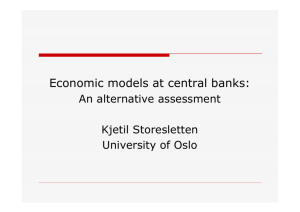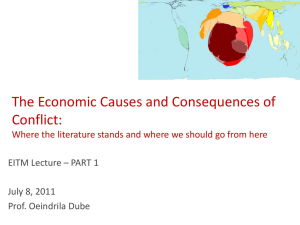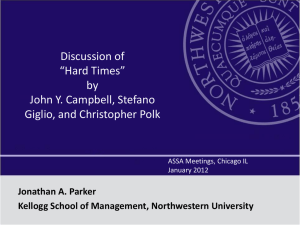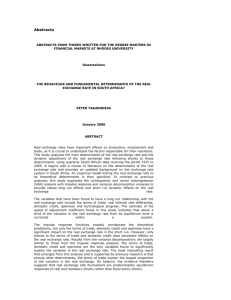A Re-Examination of Technology Shocks in Real Business Cycles: A
advertisement
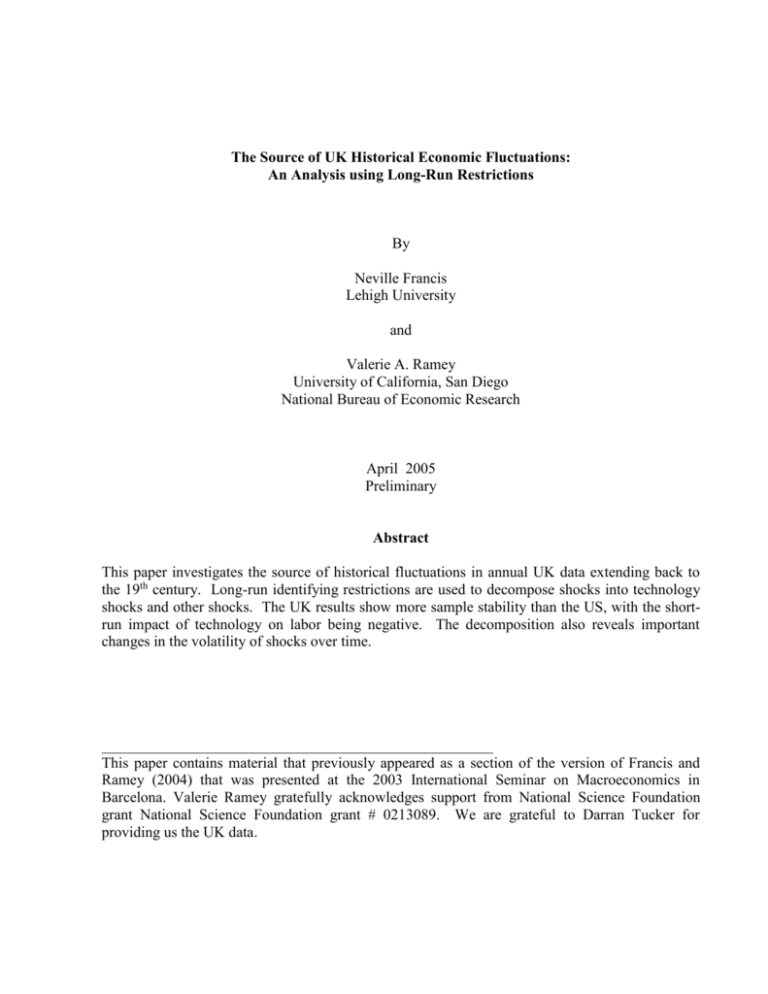
The Source of UK Historical Economic Fluctuations: An Analysis using Long-Run Restrictions By Neville Francis Lehigh University and Valerie A. Ramey University of California, San Diego National Bureau of Economic Research April 2005 Preliminary Abstract This paper investigates the source of historical fluctuations in annual UK data extending back to the 19th century. Long-run identifying restrictions are used to decompose shocks into technology shocks and other shocks. The UK results show more sample stability than the US, with the shortrun impact of technology on labor being negative. The decomposition also reveals important changes in the volatility of shocks over time. ____________________________________________________ This paper contains material that previously appeared as a section of the version of Francis and Ramey (2004) that was presented at the 2003 International Seminar on Macroeconomics in Barcelona. Valerie Ramey gratefully acknowledges support from National Science Foundation grant National Science Foundation grant # 0213089. We are grateful to Darran Tucker for providing us the UK data. I. Introduction This study examines the contribution of technology and other shocks to UK historical macroeconomic fluctuations. The paper uses methods previously applied to historical US data (Francis and Ramey (2004) as well as to post-war data for various countries (Galí (1999)). Our interest in the UK exists on several grounds. First, the UK has long and reliable macroeconomic time series extending back to the 19th century; even longer than the time series used in our earlier study of the US. Second, the UK experience has been quite different from the US over a number of periods, so it is interesting to compare the source of UK fluctuations to those of the US on a historical basis. We follow the majority in the literature and use long-run restrictions approach, as in Blanchard and Quah (1989) and Galí (1999), to identify technology shocks. To facilitate comparison with the results for the US we carry out our analysis for the entire sample period 1855-2001 and for the preand post-WWII sub-periods. Unlike its US counterpart our UK results show more sub-sample stability, with the short-run impact of technology on labor being negative regardless of the sample period. The remainder of the paper is organized as follows: Section II presents an overview of the data. The econometric methodology and results are presented in Section III. Concluding remarks are offered in Section IV. 1 II. UK Historical Data Data through 1959 came from C.H. Feinstein, National Income, Expenditure and Output for the United Kingdom 1855-1965. Due to data availability our measure of labor input is number employed rather than hours worked as is commonly used in the literature. Employment includes the armed forces and those self-employed. To work in per capita terms we divide employment by population aged 16 to 64.1 Before 1900, population numbers for this age group was available only each decade. Total population was available annually, so we interpolated the ratio between the two between decades and multiplied total population by the ratio to obtain population age 16-64. Post 1959 data on population were sent to us by the Population Unit of the Office of National Statistics (for which we thank Darren Tucker) while more recent data on productivity and employment were obtained from the statistical base of the UK. Figure 1 plots the basic series from 1855 to 2001. Output per worker shows a strong upward trend, with a noticeable dip beginning in 1919. Over the span from 1855 to 2001, employment per capita displays some low frequency movements, but no overall trend downward like the US hours per capita series (see Figure 1 of Francis and Ramey 2004 for a plot of the latter series). The Appendix provides a more detailed description of the data. III. Estimated Responses to a Technology Shock A. Econometric Methodology Given that the use of structural VARs has become standard practice in estimating technology shocks we basically borrow this section from our previous paper. We use a bivariate model of 2 labor productivity and labor input similar to the benchmark models of Galí (1999) and Francis and Ramey (2003). Under this specification technology is identified as the only shock that can have permanent effects on labor productivity. This assumption is less restrictive than Blanchard and Quah’s (1989) identification assumption since it allows non-technology shocks, such as changes in government spending, to have permanent effects on output. On the other hand, if changes in distortionary taxes affect the capital-output ratio, and hence labor productivity, this identification scheme classifies them as technology shocks. For example, a cut in capital tax rates that permanently raised labor productivity would be called a “technology shock” in our model. Consider the system: z xt C11 ( L) C12 ( L) t m n 21 22 t C ( L) C ( L) t xt denotes the log of labor productivity, nt denotes the log of labor input, z denotes the technology shock, and m denotes the non-technology shock. C(L) is a polynomial in the lag operator. We maintain the usual assumption that z and m are orthogonal. Our assumption identifying the technology shock implies that C12(1) = 0, which restricts the unit root in productivity to originate solely in the technology shock. Another way to think about this restriction is through the estimation method suggested by Shapiro and Watson (1988). Consider the following system of equations: 1 See Francis and Ramey 2004 why this measure of population may not be ideal for this kind of study. 3 (1a) (1b) p p 1 j 1 j 0 p p j 1 j 1 xt xx , j xt j xn, j 2 nt j tz . nt nn , j nt j nx , j xt j tz tm . As discussed by Shapiro and Watson (1988), imposing the long-run restriction is equivalent to restricting the other variables to enter the equation in double-differences. Because the current value of 2 nt will be correlated with tz in the first equation, instrumental variables must be used to estimate the equation. Using lags one through p of xt and nt as instruments for the first equation yields estimates that are identical to those obtained using matrix methods. The second shock to the system, tm , is identified by including the estimated residual from the first equation in the second equation, along with the standard lags of the variables, as shown in equation (1b). The estimated residual from this equation, tm , is identified as the “nontechnology” shock. This specification incorporates our baseline assumption of a unit root in hours.2 B. Impulse Responses We estimated the benchmark bivariate model with a unit root in labor productivity and labor input using the full sample 1855 – 2001, and the pre- and post-WWII subsamples. The impulse responses are presented in Figure 2. 2 We also estimate specifications with deterministically-detrended level of hours. Christiano, Eichenbaum, and Vigfusson (2003) (CEV) have argued against a unit root in hours per capita in the post-WWII US data. The results using deterministically detrending labor are similar to the unit root specification. 4 Panel A plots the impulse responses for the full sample. The response of productivity is similar to its full sample counterpart for the US where productivity first overshoots before converging to a higher steady state value. The shape of the labor response is also similar to its US counterpart; however, the initial response is negative for the UK while the US response for the unit root specification is always positive. The prewar responses are plotted in panel B and are similar to the full sample responses except for minor differences in the magnitudes of the responses. Labor again responds negatively on impact, opposite the US prewar labor response. Panel C plots the responses for the post-WWII period. Productivity displays a more hump-shaped pattern than before. Labor input responds more negatively on impact and never gets positive. The labor response for the post-WWII period is also negative, but not as persistent, for the US. Overall, the results for the UK do not suggest the dramatic changes across sub-periods that were found using US historical data. The impulse responses for the UK have the feature that labor responds negatively to a technology shock, at least in the short run regardless of the sample used, whereas its US counterpart is negative just for the postwar period. In results not shown, we found that for the period from 1855 to 1913, the effects of technology shocks on hours are even more negative than in the sample that includes WWI and the depression of the 1920s and 1930s. Therefore, results for the UK confirm the findings of Galí (1999) and Francis and Ramey (2003) that technology shocks are contractionary on the part of labor input. In this sense the UK impulse responses are qualitatively different from the impulse responses of the US. 5 C. Nature of Shocks The estimates of the shocks are shown in Figure 3 - the shaded areas represent the pre- and postWWII business cycle dates for the UK. We show the shocks estimated using the entire sample since there was less evidence of subsample instability. The largest negative technology shocks, Figure 3A, were in 1880, 1919, 1920, and 1926, whereas the largest negative nontechnology shocks, Figure 3B, were in 1879, 1884, 1908, and 1921. Finally, an interesting feature of these plots is that the nontechnology shock does a good job of picking up the recession dates. That is, invariably the recession dates coincide with dips in the nontechnology shocks. Galí (1999) had a similar finding for his US postwar nontechnology shock. Table 1 shows the variance of each type of shock for four subsamples: the pre-WWII period from 1858-1938, the post-WWII period from 1950-2001, the pre-WWI period from 1858-1913, and the interwar period from 1918-1938. The fall in variance of the technology shock is not as pronounced as in the US (a 90 percent fall for the US versus 64 percent for the UK), whereas the fall in the nontechnology shock is about the same (about 75 percent). The era of the highest volatility is the interwar period, 1918-1938. The variances of both the technology and nontechnology shocks during this period are six times higher than their variances in the postWWII period. Table 2 shows a forecast error variance decomposition for the entire period. According to the estimates, technology shocks account for all of the variance in labor productivity. On the other hand, they account for very little of the variance of hours, only 4 percent at the one year horizon 6 rising to 12 percent at the 20 year horizon. About half of the volatility of output at business cycle frequencies is accounted for by technology shocks. Are the shocks correlated between the US and UK? For the overlapping periods, 1892-1938 and 1950-2001, the correlation of the estimated technology shocks is low, equal to –0.014 and 0.291, respectively.3 The nontechnology shocks show more signs of correlations across countries, with a correlation of 0.48 and 0.402 for same periods 1892-1938 and 1950-2001, respectively. VI. Conclusions This paper has conducted a preliminary analysis of the source of shocks and their effects in the UK from 1855 to 2001. Positive technology shocks had a negative short-run impact on labor in every subsample. We also found that the volatility of both types of shocks hitting the economy during the interwar period was particularly high. While there was some correlation of the nontechnology shocks across countries, there was no evidence of correlation of the technology shocks across countries. We feel that this paper has studied only a few facets of the interesting features of the shocks identified using long-run restrictions. Further research in the area should try to augment the data to determine how the estimated shocks are correlated with other observable variables on technology and nontechnology shocks. 7 References Blanchard, Olivier and Danny Quah, “The Dynamics Effects of Aggregate Demand and Supply Disturbances,” American Economic Review, 79 (September 1989): 654-73. Christiano, Lawrence, Martin Eichenbaum, and Robert Vigfusson, “What Happens After a Technology Shock?” May 2003 manuscript. Costello, Donna, “A Cross-Country, Cross-Industry Comparison of Productivity Growth,” Journal of Political Economy, volume 101, issue 2 (April 1993). Feinstein, C.H., National Income, Expenditure and Output for the United Kingdom 1855-1965, Cambridge: Cambridge University Press, 1972. Francis, Neville and Valerie A. Ramey, “The Source of Historical Fluctuations: An Analysis Using Long-Run Restrictions,” NBER working paper 10631, July 2004. Galí, Jordi, “Technology, Employment, and the Business Cycle: Do Technology Shocks Explain Aggregate Fluctuations,” American Economic Review, 89 (March 1999): 249-271. Shapiro, Matthew D. and Mark Watson, “Sources of Business Cycle Fluctuations,” NBER Macroeconomics Annual, 1988, pp. 111 – 148. 3 The finding that technology shocks are uncorrelated across the US and UK is consistent with Costello (1993). 8 Data Appendix UK Data The historical data through 1959 are from C.H. Feinstein, National Income, Expenditure and Output for the United Kingdom 1855-1965. The historical employment data are from Table 57, column (3). No splicing is done to take into account the fact that data from 1855 – 1919 includes Southern Ireland and the data from 1920-on does not because the population figures (which divide the employment figures) have the same feature. The employment data include the armed forces and self-employed. The historical productivity data are from Table 20 of Feinstein. The population series used is for ages 16 to 64. Before 1900, population numbers for this age group was available only each decade. Total population was available annually, so we interpolated the ratio between the two between decades and multiplied total population by the ratio to obtain population age 16-64. The more recent data on population were sent to us by the Population Unit of the Office of National Statistics. The recent data on productivity and employment are from the web site: http://www.statistics.gov.uk/STATBASE. 9 Table 1: Variance of UK Shocks Time Period Technology Shocks Nontechnology Shocks 1858 – 1938 5.63 5.23 1950 – 2001 2.04 1.34 1858 - 1913 3.45 4.43 1918 - 1938 12.20 8.13 Table 2. Variance Decomposition Percent of Forecast Variance Explained by Technology Shocks Horizon (in years) Productivity Hours Output 1 2 3 4 5 10 20 99.8 99.7 99.8 99.8 99.9 99.9 100 4.2 1.8 4.9 7.5 8.9 10.7 11.5 43.1 48.1 54.1 57.2 58.8 61.2 62.3 10


